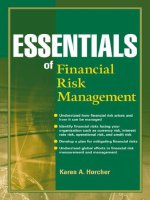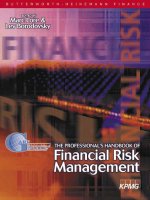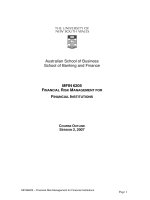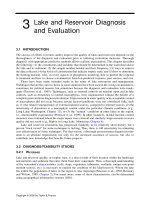Elements of financial risk management chapter 3
Bạn đang xem bản rút gọn của tài liệu. Xem và tải ngay bản đầy đủ của tài liệu tại đây (1.12 MB, 77 trang )
1
A Primer on
Financial Time Series Analysis
Elements of
Financial Risk Management
Chapter 3
Peter Christoffersen
Elements of Financial Risk Management Second Edition © 2012 by Peter Christoffersen
Overview
Topics under discussion in this Chapter
•Probability Distributions and Moments
•The Linear Model
•Univariate Time Series Models
•Multivariate Time Series Models
Elements of Financial Risk Management Second Edition © 2012 by Peter Christoffersen
2
Common pitfalls encountered while
dealing with time series data
• Spurious detection of mean-reversion
• Spurious regression
• Spurious detection of causality
Elements of Financial Risk Management Second Edition © 2012 by Peter Christoffersen
3
Univariate Probability Distributions
• Let
denote the cumulative probability
distribution of the random variable .
• The probability of being less than is given by
• Let
be the probability density of and assume
that is defined from to .
• Then the probability of having a value of less
than
Elements of Financial Risk Management Second Edition © 2012 by Peter Christoffersen
4
Univariate Probability Distributions
• Therefore, we have
• We will also have
• The probability of obtaining a value in an interval
between and where
is
Elements of Financial Risk Management Second Edition © 2012 by Peter Christoffersen
5
Univariate Probability Distributions
• The expected value or mean of is defined as
• Further we can manipulate expectations by
Where
and
are constants.
Elements of Financial Risk Management Second Edition © 2012 by Peter Christoffersen
6
Univariate Probability Distributions
• Variance is a measure of the expected variation of
variable around its mean and is defined as,
• It can also be written as
Elements of Financial Risk Management Second Edition © 2012 by Peter Christoffersen
7
Univariate Probability Distributions
• We can further write
• From this we can construct a new r.v.
,
and if the mean and variance of are zero and one
correspondingly then we have,
• This proves very useful in constructing random
variables with desired mean and variance.
Elements of Financial Risk Management Second Edition © 2012 by Peter Christoffersen
8
Univariate Probability Distributions
• Mean and variance are the first two central
moments. Third and fourth central moments, also
known as skewness and kurtosis are defined by,
• Looking closely at the formulas we will see that,
Elements of Financial Risk Management Second Edition © 2012 by Peter Christoffersen
9
Univariate Probability Distributions
• As an example we can consider the normal
distribution with parameters, and .
• It is defined by
• The normal distribution moments are:
Elements of Financial Risk Management Second Edition © 2012 by Peter Christoffersen
10
11
Bivariate Distribution
• When considering two random variables
we can define the bivariate density
and
• Covariance, the most commonly used measure of
dependence between two random variables is
defined as,
Elements of Financial Risk Management Second Edition © 2012 by Peter Christoffersen
Bivariate Distribution
• Covariance has the following properties,
• We can define correlations as,
• We have
Elements of Financial Risk Management Second Edition © 2012 by Peter Christoffersen
12
Bivariate Distribution
• A perfect positive linear relationship between and
exists if
• A perfect positive linear relationship between
and exists if
• The correlation is always bounded between -1
and +1.
Elements of Financial Risk Management Second Edition © 2012 by Peter Christoffersen
13
Conditional Distribution
• If we want to describe an RV y using information
on another RV x we can use conditional
distribution of y given x
• This definition can be used to define conditional
mean and variance
Elements of Financial Risk Management Second Edition © 2012 by Peter Christoffersen
14
Conditional Distribution
• If x and y are independent then
• This means
.
• The conditional moments can be rewritten as
Elements of Financial Risk Management Second Edition © 2012 by Peter Christoffersen
15
Sample Moments
• Here we want to introduce the standard methods for
estimating the moments introduced earlier.
• Consider sample of T observations of the variable x.
• We can estimate the mean using the sample average,
Elements of Financial Risk Management Second Edition © 2012 by Peter Christoffersen
16
Sample Moments
• Similarly, we can estimate the variance using,
• Sometimes, the sample variance formula uses
instead of
, however, unless is very small
the difference is negligible.
• Skewness and kurtosis can be estimates as,
Elements of Financial Risk Management Second Edition © 2012 by Peter Christoffersen
17
Sample Moments
• The sample covariance between two random
variables can be estimated by,
• The sample correlation between two random
variables can be found in a similar fashion by,
Elements of Financial Risk Management Second Edition © 2012 by Peter Christoffersen
18
The Linear Model
• Linear models of the type below is often used by
risk managers,
• Where
and and are assumed to be
independent or sometimes uncorrelated.
• If we know the values of then we can use the
linear model to predict ,
Elements of Financial Risk Management Second Edition © 2012 by Peter Christoffersen
19
The Linear Model
• This gives us,
• We also have that,
• This means that,
• In the linear model the variances are linked by
Elements of Financial Risk Management Second Edition © 2012 by Peter Christoffersen
20
The Linear Model
• Consider observation in the linear model.
• If we have a sample of
estimate
observation we can
Elements of Financial Risk Management Second Edition © 2012 by Peter Christoffersen
21
The Linear Model
• In the morel general linear model with different
variables we have,
• Minimizing the sum of squared errors,
provides the ordinary least squared (OLS) estimate
of ,
• OLS is built in to most common software
packages. In Excel OLS is done using LINEST
function.
Elements of Financial Risk Management Second Edition © 2012 by Peter Christoffersen
22
The Importance of Data Plots
• Linear relationship between two variables can be
deceiving
• Consider the four (artificial) data sets in table below
which are known as Anscombe’s quartet
• All four data sets have 11 observations
• Observations in the four data sets are clearly different
from each other
• The mean and variance of the x and y variables is
exactly the same across the four data sets
• The correlation between x and y are also the same
across the four pairs of variables
Elements of Financial Risk Management Second Edition © 2012 by Peter Christoffersen
23
The Importance of Data Plots
24
• We also get the same regression parameter estimates in
all the four cases
• Figure 3.1 scatter plots y against x in the four data sets
with the regression line included. We see,
• A genuine linear relationship as in the top-left panel
• A genuine nonlinear relationship as in the top-right panel
• A biased estimate of the slope driven by an outlier
observation as in the bottom-left panel
• A trivial relationship, which appears as a linear
relationship again due to an outlier
Elements of Financial Risk Management Second Edition © 2012 by Peter Christoffersen
25
Table 3.1: Anscombe's Quartet
I
II
III
IV
x
y
x
y
x
y
x
y
10
8.04
10
9.14
10
7.46
8
6.58
8
6.95
8
8.14
8
6.77
8
5.76
13
7.58
13
8.74
13
12.74
8
7.71
9
8.81
9
8.77
9
7.11
8
8.84
11
8.33
11
9.26
11
7.81
8
8.47
14
9.96
14
8.1
14
8.84
8
7.04
6
7.24
6
6.13
6
6.08
8
5.25
4
4.26
4
3.1
4
5.39
19
12.5
12
10.84
12
9.13
12
8.15
8
5.56
7
4.82
7
7.26
7
6.42
8
7.91
5
5.68
5
4.74
5
5.73
8
6.89
Mean
9.0
7.5
9.0
7.5
9.0
7.5
9.0
7.5
Variance
11.0
4.1
11.0
4.1
11.0
4.1
11.0
4.1
Moments
Correlation
0.82
0.82
0.82
0.82
a
3.00
3.00
3.00
3.00
b
0.50
0.50
0.50
0.50
Regression
Elements of Financial Risk Management Second Edition © 2012 by Peter Christoffersen









